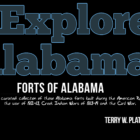Camp Clark
Camp Clark
Spanish American War Camp Camp Clark was named after Brigadier General Louis L. Clark, Alabama National Guard.
Source (12) indicates that both the 1st and 2nd Ala. Vol. Inf. assembled at Camp Clark. Newspaper articles, however, indicate there were two camps, Clark and Johnston. Camp Clark was the camp of the 1st Ala. and Camp Johnston was the camp of the 2nd Ala. Camp Clark was established about May 1, 1898. Camp Johnston was first referred to in newspaper articles about May 10, 1898.
“The Alabama volunteers are rendezvousing here rapidly, and by tomorrows’ sunset it is more than likely that the old brigade grounds on Alba’s pasture will present an appearance similar to the brigade encampments of the state guards formerly held there.” Mobile Daily Register, May 2, 1898 (extra edition), page 4. According to the May 2, 1898 Montgomery Advertiser, “Their camp has been located on the bay shore, where the usual brigade encampments of the Alabama National Guards have been held. It is situated in what is known as Albas pasture, about midway between Frascati and Monroe Park, two bayside resorts.” This site is currently industrial land in or near the Alabama State Docks. The camps were adjacent to each other southwest of the vicinity of intersection of Bay and Yeend Streets. The camp was close to the bay shore.
The 3rd Ala. Vol. Inf., an all Black regiment also was organized and mustered in at Mobile, at the same campsite, after the 1st and 2nd Ala. left for Camp Coppinger. The May 25, 1898 Nashville Banner reported that the “white volunteers object to having the battalion of Negro troops encamped near them at Camp Clark, and the Negroes will not be sent to Mobile until the white troops move out to the brigade to which they have been assigned.” The May 30, 1898 New Orleans Daily Picayune indicates the 3rd Ala. was at the “Bay Shore Camp,” the same description of the camp site of the 1st and 2nd Ala. The September 6, 1898 New Orleans Times-Democrat identified the 3rd’s camp as Camp Johnston.
Note: The Spanish–American War (Spanish: Guerra hispano-estadounidense or Guerra hispano-americana; Filipino: Digmaang Espanyol-Amerikano) was an armed conflict between Spain and the United States in 1898. Hostilities began in the aftermath of the internal explosion of USS Maine in Havana Harbor in Cuba, leading to U.S. intervention in the Cuban War of Independence. The war led to the U.S. emerging predominant in the Caribbean region,[15] and resulted in U.S. acquisition of Spain’s Pacific possessions. That led to U.S. involvement in the Philippine Revolution and ultimately to the Philippine–American War.[16]
Source: Wikipedia contributors, “Spanish–American War,” Wikipedia, The Free Encyclopedia
SOURCES
- Wright’s Official History of the Spanish-American War, published by General Marcus J. Wright, War Records Office, Washington, 1900
- Kneitel, Directory of U.S. Army Forts, Camps & Airfields (1789 to 1945), CRB Research Books, Inc., 1992
- Harpers, Leslies, Army and Navy Journal, other newspapers
- War Department, Location of Named Temporary Camps, etc., established during the War with Spain, 1898
- Report of the Commission appointed by the President to Investigate the Conduct of the War Department in the War with Spain, 1899
- Richard A. Sauers, Pennsylvania in the Spanish American War, published by the Pennsylvania Capitol Preservation Committee, 1998
- Stan Cohen, Images of the Spanish-American War, Pictorial Historians Publishing Co., Inc., 1997. This source contains many photos of camps.
- Robert B. Roberts, Encyclopedia of Historic Forts, MacMillan Publishing Company, 1988
- A Brief History of the Volunteer Organizations in the Service of the United States during the War with Spain, 1898, Appendix to Vol. 1, and other material in Correspondence relating to War with Spain, Washington, GPO, 1902, 2 volumes.
- George B. Bowers, History of the 160th Ind. Vol. Infantry in the Spanish American War, no publisher identified, no date. This is a good source for information on locations and names of little known camps.
- Powell A. Casey, Encyclopedia of Forts, Posts, Named Camps, and other Military Installations in Louisiana , 1700-1981, Claitor’s Publishing Division, 1983
- Walter Reed, Victor Vaughan and Edward Shakespeare, Report on the Origin and Spread of Typhoid Fever in U.S. Military Camps During the Spanish War of 1898, Vol. 1, Washington : Government Printing Office, 1904
- Walter Reed, Victor Vaughan and Edward Shakespeare, Report on the Origin and Spread of Typhoid Fever in U.S. Military Camps During the Spanish War of 1898, Vol. 2, Washington : Government Printing Office, 1904
